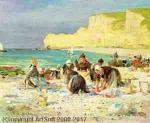Henry Bacon
Henry Bacon
Place: Watseka
Born: 1866
Death: 1924
Biography:
Henry Bacon was an American painter and author.
Henry A. Bacon was born in Haverhill, Massachusetts in 1839. During the American Civil War, he enlisted in the Union Army on 16 July 1861 and acted as a field artist for Frank Leslie's Weekly while he served as a soldier within the 13th Massachusetts Infantry. Badly wounded at Bull Run, he was discharged on 19 December 1862.
After the war, he studied art with Walter Gay, who suggested that he travel to Paris to undertake a formal art education. In 1864, he went to Paris, with his first wife Elizabeth Lord, to study figure painting. He was admitted to the National School of Fine Arts and was one of Alexandre Cabanel's scholars. He went also to Brittany and passing through Pont-Aven, he fell in love with the place. Back in Paris, he mentioned the place to his friends painters. He is credited to have been the first painter from a long group of painters to come to Pont-Aven including Paul Gaugin. This period is known nowadays as the Pont-Aven School.
He exhibited at the salon from 1868 through to 1896 with genre works which had found favour with the American market. He also worked as a journalist sending reports of events in Paris to the Boston Daily Evening Transcript. In 1897, he travelled to Egypt for the first time and began regularly spending Winters there. At that time, he switched from oils to watercolours which he believed was the optimal medium to capture the transparent light of the Middle East.
Bacon died of a heart attack in Cairo, Egypt in 1912.
The Pilgrim Hall Museum in Plymouth, Massachusetts owns The Landing of the Pilgrims,.' 1877
Égalité, 1889 Brooklyn Museum
General View of the Acropolis at Sunset, n.d. Smithsonian American Art Museum
Fisherfolk Returning with their Nets, Etretat c. 1890
Egyptian Pyramids, watercolor over graphite, 1897, Honolulu Museum of Art
Obelisk-Karnak in 1900, watercolor over graphite by Henry A. Bacon, 1900, Honolulu Museum of Art
The Spirit of the Sphinx, c. 1900, Smithsonian American Art Museum
Theatre of Dionysus, early 20th century, Smithsonian American Art Museum
More...
Wikipedia link: Click Here














